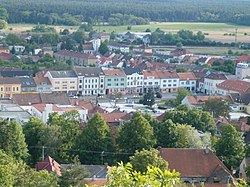Bzenec
Bzenec | |
|---|---|
Town | |
 View on Bzenec centre | |
 Flag  Coat of arms | |
 Bzenec Location in the Czech Republic | |
| Coordinates: 48°58′24″N 17°15′56″E / 48.97333°N 17.26556°ECoordinates: 48°58′24″N 17°15′56″E / 48.97333°N 17.26556°E | |
| Country | |
| Region | South Moravian |
| District | Hodonín |
| First mentioned | 1231 |
| Government | |
| • Mayor | Pavel Čejka |
| Area | |
| • Total | 40.34 km2 (15.58 sq mi) |
| Elevation | 183 m (600 ft) |
| Population (2020-01-01[1]) | |
| • Total | 4,389 |
| • Density | 110/km2 (280/sq mi) |
| Time zone | UTC+1 (CET) |
| • Summer (DST) | UTC+2 (CEST) |
| Postal code | 696 81 |
| Website | www |
Bzenec (Czech pronunciation: [ˈbzɛnɛts]; German: Bisenz) is a town in the southeast of Moravia, in the Czech Republic. It lies in the South Moravian Region. It has a population of about 4,400 inhabitants.
History[]
Bzenec was first mentioned in 1015 (as Businc Castle). The village was first mentioned in 1231. In 1330 it became a town.
Jewish history[]

About the earliest history of its Jews nothing is known. , whose "Mars Moravicus" was published in 1677, calls it "nidus Judæorum".
In the time of the margraves (up to the 15th century) the Bisenz Jews must have enjoyed great privileges; for, according to the oldest "", they were permitted to own vineyards, it being a matter of great importance to the margraves to market their wine through the agency of Jewish traders. In the wars between George of Poděbrady of Bohemia and Matthias of Hungary (c. 1458), Bisenz, and with it the Jewish quarter, was entirely devastated and came under constantly changing feudal proprietors.
According to the feudal "Urbarium" of 1604, the Jews even then possessed 32 houses, a hospital, and 17 smaller buildings, called "Hoferi Židovští." But only a year later (May 2, 1605) the Jewish community was totally destroyed by Stephen Bocskai; so that in 1655, when the new edition of the land-register was made out, 25 Jewish holdings still lay in ruins.
In the first Silesian war (Feb., 1742) the Jewish community suffered severely from the Prussian invasion, especially as its inhabitants had to bear their share of the general levies. At the close of this war the empress Maria Theresa in 1753 issued the so-called "Familien-Verordnung" (Family Ordinance), according to which only 5,442 Jewish families were allowed to live in Moravia; and of these 137 were allotted to Bisenz. On May 17, 1777, almost the entire Jewish ghetto, in which there were 93 houses, was burned. Up to 1782 the Jewish community was subject to the feudal lord; but in criminal matters they were under the jurisdiction of the city authorities.
Of recent events may be mentioned the organization of the Jewish congregation into a political community in 1852, and the building of a new synagogue in 1863. [2]
Economy[]
The town has a long history of wine production.
Notable people[]
- Rudolf Auspitz (1837–1906), Austrian industrialist, economist; lived here
- Nehemiah Brüll (1843–1891), rabbi; lived here
- Max Kurzweil (1867–1916), Austrian Jewish painter, graphic artist
- (1873–1945), Austrian Jewish merchant and inventor, father of Wolfgang Paalen
- Norbert Jokl (1877–1942), Austrian Jewish linguist, father of Albanology
- (1914–1998), Swiss journalist of Jewish origin
Twin towns – sister cities[]
 Egeln, Germany
Egeln, Germany Mûrs-Erigné, France
Mûrs-Erigné, France
References[]
- ^ "Population of Municipalities – 1 January 2020". Czech Statistical Office. 30 April 2020.
- ^
 This article incorporates text from a publication now in the public domain: Gotthard Deutsch, (1901–1906). "Bisenz". In Singer, Isidore; et al. (eds.). The Jewish Encyclopedia. New York: Funk & Wagnalls.
This article incorporates text from a publication now in the public domain: Gotthard Deutsch, (1901–1906). "Bisenz". In Singer, Isidore; et al. (eds.). The Jewish Encyclopedia. New York: Funk & Wagnalls.
- ^ "Partnerská města" (in Czech). Město Bzenec. Retrieved 15 September 2020.
| Wikimedia Commons has media related to Bzenec. |
- Populated places in Hodonín District
- Cities and towns in the Czech Republic
- Moravian Slovakia
- Jewish communities in the Czech Republic
- Shtetls

